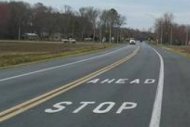Article from: www.thenewspaper.com/news/23/2327.asp
4/17/2008
Study Finds Cost Effective Methods of Reducing Stop Sign Accidents
US Department of Transportation study finds effective and inexpensive alternatives to cameras to reduce accidents at stop signs.
 The Federal Highway Administration (FHWA) last month released a pair of studies evaluating the benefit of simple measures municipalities can take to reduce the number of crashes at intersections controlled by stop signs. The agency commissioned the studies as part of a larger effort to find cost-effective engineering alternatives. The precise impact of increasing the reflectivity of stop signs and using pavement warnings before now had never been examined in a controlled study.
The Federal Highway Administration (FHWA) last month released a pair of studies evaluating the benefit of simple measures municipalities can take to reduce the number of crashes at intersections controlled by stop signs. The agency commissioned the studies as part of a larger effort to find cost-effective engineering alternatives. The precise impact of increasing the reflectivity of stop signs and using pavement warnings before now had never been examined in a controlled study.
Researchers first measured the effect of "stop ahead" pavement markings that warn motorists of upcoming intersections. The study included eight sites in Arkansas and nine in Maryland to determine the change in the number of accidents after the warnings were put in place.
"The aggregate analysis in Arkansas and Maryland indicates that stop ahead pavement markings may significantly reduce total crashes at unsignalized intersections," the report found.
A conservative analysis of the data suggested the markings created a fifteen percent reduction in accidents at a very low cost. On an annualized basis a local government would spend between $78 and $366 per intersection approach to keep the warnings in good condition.
The second study examined the use of photoreflective sheeting to make stop signs more visible at night. Researchers looked at 231 sites in Connecticut and 108 sites in South Carolina to discover that the benefit was limited to certain types of intersections -- mostly low-volume rural locations -- that have a particular nighttime crash problem.
"At higher volume intersections, there are more visual cues for minor road motorists approaching a stop-controlled intersection," the report found. "However, given the low cost of this strategy, even with conservative assumptions, only a very modest reduction in crashes is needed to justify its use."
A set of extra-reflective signs costs about $200 per intersection to install.
Source: TechBriefs on Increasing Safety at Stop Signs (Federal Highway Administration, 3/28/2008)
Permanent Link for this item
Return to Front Page
 The Federal Highway Administration (FHWA) last month released a pair of studies evaluating the benefit of simple measures municipalities can take to reduce the number of crashes at intersections controlled by stop signs. The agency commissioned the studies as part of a larger effort to find cost-effective engineering alternatives. The precise impact of increasing the reflectivity of stop signs and using pavement warnings before now had never been examined in a controlled study.
The Federal Highway Administration (FHWA) last month released a pair of studies evaluating the benefit of simple measures municipalities can take to reduce the number of crashes at intersections controlled by stop signs. The agency commissioned the studies as part of a larger effort to find cost-effective engineering alternatives. The precise impact of increasing the reflectivity of stop signs and using pavement warnings before now had never been examined in a controlled study.